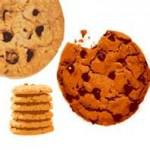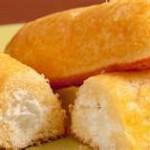If you are like many of us in the US, inventorying your pantry is key to changing your eating and snacking style.
For us grandparents, parents and older kids it’s going to be a not so fun retraining process, but for our little ones, it’s the gift of learning to eat healthy from the start.
We all know that eating patterns and food preferences are learned at an early age and primarily at home. One of the first learning sites, in addition to the dining room table and the refrigerator with its sweet sodas and juices, ice creams and sugary pops, is the food pantry.
 The pantry,with its pound-packing but oh so satisfying quick and easy snacks, is just where many of our
The pantry,with its pound-packing but oh so satisfying quick and easy snacks, is just where many of our  kids go for that after school snack and where most of us head when an attack of the munchies hits while watching TV or using the computer. Who doesn’t like staring into a well-stocked pantry and picking out something comforting and filling from the assortment of cookies, buttery popcorn, cellophane wrapped cakes and baked snacks, sugary cereals, and chips?
kids go for that after school snack and where most of us head when an attack of the munchies hits while watching TV or using the computer. Who doesn’t like staring into a well-stocked pantry and picking out something comforting and filling from the assortment of cookies, buttery popcorn, cellophane wrapped cakes and baked snacks, sugary cereals, and chips?


To help with your pantry inventory, here is a list of the 10 worst and 10 best foods to have in your pantry from the article, “The Best and Worst Foods in Your Pantry” a WebMD Feature by Elaine Magee, MPH, RD and reviewed by Kathleen M. Zelman, MPH, RD, LD
10 Worst Foods In Your Pantry
1. Soda and Sweetened Beverages
Some of the worst foods in the pantry are soda and other sweetened drinks because these contribute refined carbohydrate calories without nutrients. David Leopold, MD, director of integrative medical education for the Scripps Center for Integrative Medicine, puts any type of soda at the top of his “worst” list. Some might be surprised that sweetened teas and energy drinks rival the sugar in soda with about 50 grams of sugar per 16-ounce bottle.
2. High Sugar, Low Fiber Breakfast Cereals
Cold cereals are among the top sources of added sugar for children between the ages of 2 and 8, according to a recent report. A cereal that lists a refined grain and sugar as the first two ingredients won’t satisfy your hunger through the morning and it won’t contribute important nutrients, which come from whole foods like whole grains, nuts, or dried fruit.
3. Snack Cakes and Cupcakes
Snack cakes have three of the four ingredients we need to eat less of: refined flour, added sugars, and saturated fat. The typical snack cake serving, such as two Hostess Ho Hos, contains 228 calories, 9 grams of saturated fat, and 28 grams of sugar. Keep in mind that 9 grams of saturated fat is half the maximum daily amount of saturated fat recommended for someone eating 1,800 calories a day, according to the 2010 Dietary Guidelines.
4. Movie Theater or Mega Butter Microwave Popcorn
The “Extra Butter” or “Movie Theater” microwave popcorn choices are some of the last products that still have shocking amounts of trans fat in them with a small serving of 3 tablespoons (unpopped) containing about 2.5 grams of saturated fat and 5 grams of trans fat. Each serving also adds at least 300 milligrams of sodium to your day’s total.
5. Chips and Cheetos
This popular snack group category makes the list because they are processed with gobs of fat and sodium and usually include a refined grain. A 2-ounce bag of chips or Cheetos usually adds more than 300 calories, 20 grams of fat, and over 450 milligrams of sodium. The worst part is we tend to eat too much of them because even a 2-ounce portion doesn’t seem to satisfy our stomach.
6. Packaged Muffins and Cereal Bars
You expect Pop Tarts to be full of sugar (about 16 grams of sugar each) but you might be surprised to learn that even the more healthful sounding cereal bars or packaged muffins contain about the same amount of sugar (or more) than your typical toaster pastry. Otis Spunkmeyer brand muffins contribute about 30 grams of sugar per 4-ounce muffin, Weight Watchers muffins add about 20 grams of sugar per 2.2-ounce muffin, and a small Nutri-Grain cereal bar has 13 grams of sugar.
7. Crackers (made with refined flour)
They are so easy to eat a lot of because they are bite-size and crunchy. A few years ago crackers were held together with partially hydrogenated fat (which added trans fat) and now the trans fats are mostly gone, but most crackers are still low in fiber and high in sodium.
8. Yeast Breads (made with refined flour)
Yeast breads, from hot dog buns to Texas toast, made the “worst” list for two reasons: They are one of the biggest sources of refined flour in the typical American diet and they are also the No. 1 source of sodium among the U.S. population.
9. Store-Bought Cookies (especially the chocolate coated ones)
Grain desserts, which includes cookies, are a major source of added sugars, more so than dairy desserts or candy, according to a new report. Some commercial cookies are higher in fat, saturated fat and sugar than others but they all usually start with refined flour. The chocolate coated cookies tend to have the most saturated fat (about 5 grams per 3 cookie serving).
10. Canned Soup and Instant Noodle Cups
Some choices in the soup aisle have half a day’s worth of sodium in a serving. The U.S. Dietary Guidelines recommend half the U.S. population, including people aged 51 and older and those of any age who are African-American or have hypertension, diabetes, or chronic kidney disease, reduce their sodium to 1,500 milligrams a day.
10 Best Foods In Your Pantry
1. Unsalted or Lightly Salted Nuts
With three times the protein and fiber as potato chips but none of the sodium, nuts are pantry favorites of Neva Cochran, MS, RD, a nutrition consultant in Dallas. “Unsalted nuts beat chips as a filling snack to thwart hunger,” says Cochran.
2. Low-Salt Canned Beans
Beans are a great source of protein, phytochemicals, and fiber and they are on Leopold’s list of “best” foods to have in your pantry. All the major bean types are available in a “less salt” or “reduced sodium” option. Just open a can, rinse, drain, and pour the beans into your stew, salad, casserole, or chili.
3. Low-Salt Canned Tuna or Salmon
Packed with heart-smart omega-3s, salmon or tuna in a can or pouch can make a quick sandwich or casserole super convenient. Canned tuna is one of Cochran’s go-to pantry protein sources with 26 grams of quality protein per 5-ounce can.
4. Lower Sugar Instant Oatmeal
Making oatmeal from scratch is best, but if you only have a few minutes in the morning instant oatmeal is the start of a quick and balanced breakfast. Make it with low or nonfat milk instead of water to add protein and calcium. While it’s cooking in the microwave, chop up some fresh or frozen fruit to stir in once it’s done. The lower sugar instant oatmeal brands have around 25% less sugar than the regular types, but you still get 3 grams fiber and 4 grams protein per packet.
5. Whole-Grain Breakfast Cereals
Almost every family has at least a couple of boxes of breakfast cereal in their pantry. The best cereal choices have a whole grain as the first ingredient and contain at least 5 grams of fiber per serving and not more than 8 grams of sugar per serving, such as Grape-Nuts, Kashi Go Lean, or Shredded Wheat. Since natural sweetness from dried fruit is included in the “sugar” total on the Nutrition Facts label, there are cereals like Kellogg’s Raisin Brain that are still a great choice even though they have more than 8 grams sugar per serving. The dried fruit in this cereal appears high in the ingredient list than added sugar.
6. Extra Virgin Olive Oil and Canola Oil
Heart-healthy monounsaturated fat and phytochemicals make olive oil a great addition to your meals and cooking. Cochran uses olive oil as a dip for bread, an ingredient in salad dressings, and as a cooking fat for chicken and fish. Ansel suggests having canola oil in addition to olive oil in your pantry because each is preferable for different culinary purposes.
7. Whole-Grain or Whole Wheat Pasta
Dinner is only 10 minutes away when you have pasta in the pantry. Make it whole wheat or whole-grain pasta and the fiber and important nutrients skyrocket. Each 2-ounce serving contributes about 6 grams of fiber, 7 grams of protein, and phytochemicals coming from the whole grains. (A 2-ounce serving of white pasta contains 1.8 grams of fiber.)
8. Whole-Grain Quinoa
Quinoa can also be cooked in a rice cooker, but it has twice the fiber, protein, and iron as the same amount of brown rice. They each have about 170 calories per 1/4 cup dry. Cooked quinoa can be added to entrees, soups and stews, and salads calling for cooked whole grains.
9. Green Tea Bags
With each sip of unsweetened green tea, you get two potent flavonoids — anthocyanin and proanthocyanidin — as well as a healthy dose of catechin. All are powerful phytochemicals with suspected antioxidant and anti-inflammatory action in the body. And the best part of drinking more green tea (choose decaf if you are sensitive to caffeine) is that you are likely drinking less of other beverages on the “worst” list above, like sodas or fruit drinks.
10. Dark Chocolate With 60% Cacao or Unsweetened Cocoa
Possible health benefits stem from the cacao plant being extraordinarily rich in antioxidant phytochemicals called flavonols. Leopold agrees that dark chocolate is one of the best foods to put in your pantry, although more research needs to be done. Recent studies suggest that dark chocolate and cocoa may ease emotional stress, reduce the risk of cardiovascular disease, decrease blood pressure, and increase insulin sensitivity. But keep in mind, dark chocolate is also loaded with fat, sugar, and calories, so enjoy a small portion.

